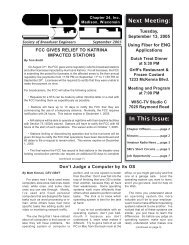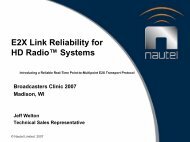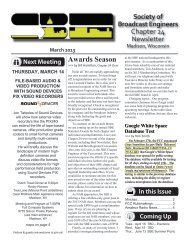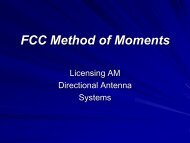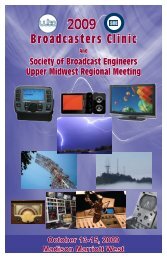Methods to Improve HD Radio Coverage - SBE Chapter 24
Methods to Improve HD Radio Coverage - SBE Chapter 24
Methods to Improve HD Radio Coverage - SBE Chapter 24
Create successful ePaper yourself
Turn your PDF publications into a flip-book with our unique Google optimized e-Paper software.
WBA / <strong>SBE</strong> Broadcasters Clinic<br />
<strong>Methods</strong> <strong>to</strong> <strong>Improve</strong><br />
<strong>HD</strong> <strong>Radio</strong> <strong>Coverage</strong><br />
presented by:<br />
Geoffrey N. Mendenhall, P.E.<br />
VP Transmission Research and Technology<br />
Harris Broadcast Communications, Mason, Ohio<br />
<strong>Methods</strong> <strong>to</strong> <strong>Improve</strong> <strong>HD</strong> <strong>Radio</strong> <strong>Coverage</strong><br />
assuredcommunications<br />
WBA Oc<strong>to</strong>ber 26, 2010
TOPICS TO BE COVERED<br />
• The need <strong>to</strong> increase <strong>HD</strong> <strong>Radio</strong> sideband power<br />
• Optimized 6dB power increase<br />
• RF amplifier linearity challenge<br />
• Combining methods <strong>to</strong> higher <strong>HD</strong> <strong>Radio</strong> sideband levels<br />
• Space Combining<br />
• Common Amplification<br />
• Re-use of existing <strong>HD</strong> <strong>Radio</strong> equipment <strong>to</strong> increase digital<br />
sideband levels<br />
• High power Filterplexers<br />
• Sharp tuned RF mask filters<br />
• More <strong>HD</strong> power with Hybrid Crest Fac<strong>to</strong>r Reduction<br />
• Unequal <strong>HD</strong> <strong>Radio</strong> sidebands <strong>to</strong> prevent interference<br />
• <strong>HD</strong> <strong>Radio</strong> Gap Filler solutions<br />
• <strong>HD</strong> <strong>Radio</strong> Transla<strong>to</strong>rs<br />
• <strong>HD</strong> <strong>Radio</strong> signal quality measurement<br />
<strong>Methods</strong> <strong>to</strong> <strong>Improve</strong> <strong>HD</strong> <strong>Radio</strong> <strong>Coverage</strong><br />
assuredcommunications<br />
WBA Oc<strong>to</strong>ber 26, 2010
GOALS OF INCREASING <strong>HD</strong> RADIO POWER<br />
• Reliable reception of multicast channels - no analog fall<br />
back<br />
• Better building penetration <strong>to</strong> portable and desk<strong>to</strong>p<br />
receivers<br />
• Better mobile reception in suburban areas<br />
• Better reception on portable receivers with poor<br />
antennas<br />
<strong>Methods</strong> <strong>to</strong> <strong>Improve</strong> <strong>HD</strong> <strong>Radio</strong> <strong>Coverage</strong><br />
assuredcommunications<br />
WBA Oc<strong>to</strong>ber 26, 2010
CORRECTLY SIZE TRANSMITTER UPGRADE<br />
• Do I size my transmission plant for -14, -12, or -10dBc?<br />
• Do I size for asymmetrical <strong>HD</strong> sidebands?<br />
• All FM stations permitted <strong>to</strong> increase both <strong>HD</strong> sidebands<br />
levels by +6 dB<br />
• Grandfathered, super power stations, may get less<br />
• FCC site at: http://www.fcc.gov/mb/audio/digitalFMpower.html<br />
• Many stations able <strong>to</strong> increase power of one or both <strong>HD</strong><br />
sidebands 4dB more with asymmetrical <strong>HD</strong> sidebands<br />
• Additional power for asymmetrical sidebands needs <strong>to</strong> be<br />
considered in selecting the proper size transmitter<br />
• Estimated 91% commercial band stations and 82% noncommercial<br />
band segment stations can increase one <strong>HD</strong><br />
sideband <strong>to</strong> -10dBc<br />
• Estimated 58% commercial band stations and 50% noncommercial<br />
band segment could increase both <strong>HD</strong> sidebands<br />
<strong>to</strong> the -10dBc<br />
<strong>Methods</strong> <strong>to</strong> <strong>Improve</strong> <strong>HD</strong> <strong>Radio</strong> <strong>Coverage</strong><br />
assuredcommunications<br />
WBA Oc<strong>to</strong>ber 26, 2010
LINEARITY CHALLENGE - HIGHER <strong>HD</strong> POWER<br />
• Higher AM component of increased IBOC power means<br />
common amplification transmitter must be further derated<br />
from Class ”C” saturated FM operation<br />
• <strong>HD</strong>-only, separate amplification without linearizing effect<br />
of constant envelope analog FM signal - maximum<br />
power must be reduced <strong>to</strong> improve IMD suppression<br />
• At -10dBc (10%) injection, RF IMD must be suppressed<br />
additional 10dB at same time power output is increased<br />
by 10dB<br />
• 20dB linearity improvement from -20dBc (1%) <strong>to</strong><br />
maintain the original RF mask compliance<br />
<strong>Methods</strong> <strong>to</strong> <strong>Improve</strong> <strong>HD</strong> <strong>Radio</strong> <strong>Coverage</strong><br />
assuredcommunications<br />
WBA Oc<strong>to</strong>ber 26, 2010
RF MASK FOR -20dBc IBOC SIDEBANDS<br />
0.00<br />
-10.00<br />
FM<strong>HD</strong> -20dBc<br />
-20.00<br />
-30.00<br />
Pout (dBm)<br />
-40.00<br />
-50.00<br />
-60.00<br />
~35dB<br />
-70.00<br />
-80.00<br />
-90.00<br />
97.30 97.40 97.50 97.60 97.70 97.80 97.90 98.00 98.10 98.20 98.30 98.40 98.50<br />
Freq (MHz)<br />
<strong>Methods</strong> <strong>to</strong> <strong>Improve</strong> <strong>HD</strong> <strong>Radio</strong> <strong>Coverage</strong><br />
assuredcommunications<br />
WBA Oc<strong>to</strong>ber 26, 2010
RF MASK FOR -14dBc IBOC SIDEBANDS<br />
0.00<br />
-10.00<br />
FM<strong>HD</strong>-14dBc<br />
-20.00<br />
-30.00<br />
Pout (dBm)<br />
-40.00<br />
-50.00<br />
-60.00<br />
~41dB<br />
-70.00<br />
-80.00<br />
-90.00<br />
97.30 97.40 97.50 97.60 97.70 97.80 97.90 98.00 98.10 98.20 98.30 98.40 98.50<br />
Freq (MHz)<br />
<strong>Methods</strong> <strong>to</strong> <strong>Improve</strong> <strong>HD</strong> <strong>Radio</strong> <strong>Coverage</strong><br />
assuredcommunications<br />
WBA Oc<strong>to</strong>ber 26, 2010
RF MASK FOR -10dBc IBOC SIDEBANDS<br />
0.00<br />
-10.00<br />
FM<strong>HD</strong> -10dBc<br />
-20.00<br />
-30.00<br />
Pout (dBm)<br />
-40.00<br />
-50.00<br />
-60.00<br />
~45dB<br />
-70.00<br />
-80.00<br />
-90.00<br />
97.30 97.40 97.50 97.60 97.70 97.80 97.90 98.00 98.10 98.20 98.30 98.40 98.50<br />
Freq (MHz)<br />
<strong>Methods</strong> <strong>to</strong> <strong>Improve</strong> <strong>HD</strong> <strong>Radio</strong> <strong>Coverage</strong><br />
assuredcommunications<br />
WBA Oc<strong>to</strong>ber 26, 2010
10DB HIGH LEVEL COMBINING -20 VS. -10 dBc<br />
Conventional 10dB High-Level<br />
combining is not practical in terms<br />
of capital expense or operating<br />
efficiency for more than 2dB<br />
increase in IBOC injection<br />
Lic. TPO 20,000 Watts<br />
<strong>HD</strong><br />
Injection<br />
dB<br />
-20<br />
-18<br />
-16<br />
-14<br />
-13<br />
-12<br />
-10<br />
<strong>HD</strong><br />
Power<br />
Watts<br />
2,000<br />
3,170<br />
5,0<strong>24</strong><br />
7,962<br />
10,0<strong>24</strong><br />
12,619<br />
20,000<br />
Combiner -10 dBc<br />
Reject Watts<br />
4,022<br />
5,075<br />
6,744<br />
9,388<br />
11,<strong>24</strong>4<br />
13,579<br />
20,222<br />
10<br />
20<br />
-4.77<br />
-6.02<br />
-10<br />
20222<br />
IBOC Injection<br />
18000 -10 2000<br />
2,222 dBc 20,000<br />
20,000<br />
-10 dB<br />
Combiner<br />
Analog 22,222 Watts 20,000 IBOC<br />
<strong>Methods</strong> <strong>to</strong> <strong>Improve</strong> <strong>HD</strong> <strong>Radio</strong> <strong>Coverage</strong><br />
assuredcommunications<br />
WBA Oc<strong>to</strong>ber 26, 2010
OPTIMIZED +6DB <strong>HD</strong> POWER INCREASE<br />
• Stations want full +6dB increase in <strong>HD</strong> power<br />
• Practical choices <strong>to</strong> increase <strong>HD</strong> radio power<br />
– Space combining separate analog and digital<br />
transmitters<br />
– Conversion of split-level systems or high level<br />
systems <strong>to</strong> unequal combining of common<br />
amplification transmitters<br />
– Common amplification of FM + <strong>HD</strong> through a single<br />
transmitter<br />
• High level or split-level combining not practical for <strong>HD</strong><br />
increase of more than +3dB<br />
<strong>Methods</strong> <strong>to</strong> <strong>Improve</strong> <strong>HD</strong> <strong>Radio</strong> <strong>Coverage</strong><br />
assuredcommunications<br />
WBA Oc<strong>to</strong>ber 26, 2010
SPACE COMBINING OR COMMON AMPLIFICATION?<br />
• Space combining - most cost effective way <strong>to</strong> increase the <strong>HD</strong><br />
power using the existing antennas and analog FM transmitter<br />
• If system isolation + power handling requirements can be met,<br />
increasing the digital transmitter power is the only equipment<br />
change<br />
• Shortcoming is mis-tracking between analog FM and <strong>HD</strong> signal<br />
levels due <strong>to</strong> differences in radiation patterns of two antennas<br />
• Single array with opposite circular polarizations for FM + <strong>HD</strong> still<br />
has mis-tracking where multi-path polarizations add up differently<br />
• FM / <strong>HD</strong> tracking important <strong>to</strong> avoid digital <strong>to</strong> host interference at<br />
higher <strong>HD</strong> power levels<br />
• Only way for FM and <strong>HD</strong> signals track perfectly - radiate <strong>to</strong>gether<br />
from single antenna with identical radiation pattern and<br />
polarization<br />
• Requires FM + <strong>HD</strong> mixed in single transmission line <strong>to</strong> the<br />
antenna<br />
• Most practical way is common amplification transmitter of both<br />
signals in proper ratio<br />
<strong>Methods</strong> <strong>to</strong> <strong>Improve</strong> <strong>HD</strong> <strong>Radio</strong> <strong>Coverage</strong><br />
assuredcommunications<br />
WBA Oc<strong>to</strong>ber 26, 2010
UPGRADING A SPACE COMBINED SYSTEM<br />
• 6dB increase <strong>to</strong> -14dBc = digital transmitter <strong>to</strong> 4 x current power<br />
• Some headroom <strong>to</strong> increase power some number of dB now ??<br />
• Isolation between analog FM transmitter and digital transmitter<br />
needs <strong>to</strong> increase “dB for dB” in direct proportion <strong>to</strong> the digital<br />
transmitter power increase<br />
• Exact isolation requirement will depend on the mixing “turn-aroundloss”<br />
of both the analog and digital transmitters -> higher “turnaround-loss”<br />
requires less isolation<br />
• Limiting fac<strong>to</strong>r driving isolation requirement is frequently “turnaround-loss”<br />
of high power analog FM transmitter<br />
• Power ratings of multi-station combining system, transmission line,<br />
and antenna may need <strong>to</strong> be upgraded<br />
<strong>Methods</strong> <strong>to</strong> <strong>Improve</strong> <strong>HD</strong> <strong>Radio</strong> <strong>Coverage</strong><br />
assuredcommunications<br />
WBA Oc<strong>to</strong>ber 26, 2010
SPACE COMBINING -20 dBc VS. -10 dBc<br />
HPX<br />
>30 dB isolation<br />
Turn-around-loss in<br />
tube type analog<br />
transmitter can be a<br />
little as 6dB<br />
Typically 30-40dB<br />
isolation is required<br />
between a solid-state<br />
<strong>HD</strong> <strong>Radio</strong> transmitter<br />
and the tube type<br />
Analog transmitter<br />
HPX<br />
>40 dB isolation<br />
A low power circula<strong>to</strong>r<br />
may be required on<br />
the digital transmitter.<br />
A high power<br />
circula<strong>to</strong>r or a sharp<br />
tuned filter may be<br />
required on the tube<br />
transmitter<br />
<strong>Methods</strong> <strong>to</strong> <strong>Improve</strong> <strong>HD</strong> <strong>Radio</strong> <strong>Coverage</strong><br />
assuredcommunications<br />
WBA Oc<strong>to</strong>ber 26, 2010
MAX <strong>HD</strong>-ONLY TPO – SEPARATE AMPLIFICATION<br />
Without the linearizing effect of the<br />
constant envelope analog FM<br />
signal, the maximum available TPO<br />
must be reduced <strong>to</strong> improve<br />
linearity and IMD suppression<br />
As the IBOC sideband power ratio<br />
is increased, power output of the<br />
IBOC only transmitter is increasing<br />
and the RF inter-modulation<br />
products need <strong>to</strong> be further<br />
suppressed by the same ratio <strong>to</strong><br />
maintain original mask compliance.<br />
This table displays the maximum IBOC RF power output, in watts,<br />
available from each Harris <strong>HD</strong> transmitter when operating Digital Only for<br />
IBOC sideband injection levels from -20 dBc through -10dBc<br />
<strong>Methods</strong> <strong>to</strong> <strong>Improve</strong> <strong>HD</strong> <strong>Radio</strong> <strong>Coverage</strong><br />
assuredcommunications<br />
WBA Oc<strong>to</strong>ber 26, 2010
COMMON AMPLIFICATION<br />
Analog<br />
Excitation<br />
E2X<br />
IP<br />
Transport<br />
Analog<br />
Processor<br />
FlexStar <strong>HD</strong>x<br />
FM+<strong>HD</strong><br />
Exciter<br />
Digital<br />
Excitation<br />
Aux RF<br />
Out<br />
Common<br />
Amplification<br />
Transmitter<br />
Analog Signal<br />
Digital Signal<br />
<strong>Methods</strong> <strong>to</strong> <strong>Improve</strong> <strong>HD</strong> <strong>Radio</strong> <strong>Coverage</strong><br />
assuredcommunications<br />
WBA Oc<strong>to</strong>ber 26, 2010
UPGRADING COMMON AMPLIFICATION SYSTEM<br />
• Increasing <strong>HD</strong> power in FM + <strong>HD</strong> common amplification system<br />
simply involves additional headroom in transmitter <strong>to</strong> handle<br />
increased peak <strong>to</strong> average ratio of the hybrid signal<br />
• Key advantage is ability <strong>to</strong> use existing, single, antenna providing<br />
identical radiation patterns and polarization FM+<strong>HD</strong><br />
• Nearly perfect signal tracking of FM + <strong>HD</strong> radio signals at all<br />
locations<br />
• Power rating of Tx increasing <strong>HD</strong> power -20dBc <strong>to</strong> -14dBc with<br />
standard crest fac<strong>to</strong>r reduction will be approximately (70%) of the<br />
-20dBc rating and approximately (85%) of the -20dBc rating with<br />
hybrid crest fac<strong>to</strong>r reduction<br />
• If common amplification transmitter does not have headroom <strong>to</strong><br />
go <strong>to</strong> -14dBc or -10dBc, addition of second transmitter combined<br />
with a 3dB hybrid offers several advantages<br />
• Combined system provides full back-up of FM + <strong>HD</strong> <strong>Radio</strong><br />
• Nearly full FM analog power possible on either transmitter alone<br />
by reducing the <strong>HD</strong> sideband power level back <strong>to</strong> -20dBc<br />
<strong>Methods</strong> <strong>to</strong> <strong>Improve</strong> <strong>HD</strong> <strong>Radio</strong> <strong>Coverage</strong><br />
assuredcommunications<br />
WBA Oc<strong>to</strong>ber 26, 2010
HIGH POWER COMMON AMPLIFICATION<br />
– Single HPX provides <strong>to</strong>tal FM+<strong>HD</strong><br />
TPO of 17kW at -10dBc<br />
– Single HPX provides <strong>to</strong>tal FM+<strong>HD</strong><br />
TPO of <strong>24</strong>kW at -14dBc<br />
– Dual HPX provides <strong>to</strong>tal FM+<strong>HD</strong><br />
TPO of 33kW at -10dBc<br />
– Dual HPX provides <strong>to</strong>tal FM+<strong>HD</strong><br />
TPO of 47kW at -14dBc<br />
Dual HPX- 40 Common Amp<br />
@ -10dBc = 33,000 W Max<br />
@ -14dBc = 47,000 W Max<br />
<strong>Methods</strong> <strong>to</strong> <strong>Improve</strong> <strong>HD</strong> <strong>Radio</strong> <strong>Coverage</strong><br />
assuredcommunications<br />
WBA Oc<strong>to</strong>ber 26, 2010
MAXIMUM TPO FOR COMMON AMPLIFICATION<br />
Harris Transmitter<br />
FM<br />
FM+<strong>HD</strong> Common Amplification TPO - IBOC <strong>to</strong> FM Ratio (dBc) with standard digital only crest fac<strong>to</strong>r reduction<br />
-20dBc -18dBc -16dBc -14dBc -12dBc -10dBc<br />
Com FM IBOC Com FM IBOC Com FM IBOC Com FM IBOC Com FM IBOC Com FM IBOC<br />
ZX500 550 413 409 4 390 384 6 350 341 9 314 302 12 286 269 17 267 <strong>24</strong>3 <strong>24</strong><br />
ZX1000 1100 852 844 8 780 768 12 700 683 17 628 604 <strong>24</strong> 572 538 34 534 485 49<br />
ZX2000 2200 1704 1687 17 1560 1536 <strong>24</strong> 1400 1366 34 1256 1208 48 1144 1076 68 1068 971 97<br />
ZX2500 2750 2130 2109 21 1950 1920 30 1750 1707 43 1570 1510 60 1430 1345 85 1335 1214 121<br />
ZX3500 3850 2800 2772 28 2563 2523 40 2300 2<strong>24</strong>4 56 2064 1985 79 1880 1768 112 1755 1595 160<br />
ZX3750 4125 3195 3163 32 2925 2879 46 2625 2561 64 2355 2265 91 2145 2018 127 2003 1820 182<br />
Z4<strong>HD</strong>+ 5500 2050 2030 20 1925 1895 30 1725 1683 42 1545 1486 59 1405 1322 83 1310 1191 119<br />
Z6<strong>HD</strong>+ 2200 3075 3045 30 2888 2842 45 2588 25<strong>24</strong> 63 2318 2228 89 2108 1982 125 1965 1786 179<br />
ZX5000 5500 4260 4218 42 3900 3839 61 3500 3414 86 3140 3019 121 2860 2690 170 2670 <strong>24</strong>27 <strong>24</strong>3<br />
Z8<strong>HD</strong>+ 5250 4100 4059 41 3850 3790 60 3450 3365 85 3090 2971 119 2810 2643 167 2620 2382 238<br />
Z12<strong>HD</strong>+ 7800 6150 6089 61 5775 5685 90 5175 5048 127 4635 4457 178 4215 3965 250 3930 3573 357<br />
Z16<strong>HD</strong>+ 10500 8200 8119 81 7700 7580 120 6900 6731 169 6180 5943 238 5620 5286 334 5<strong>24</strong>0 4764 476<br />
ZD<strong>24</strong><strong>HD</strong>+ 15600 12300 12178 122 11550 11370 180 10350 10096 254 9270 8914 357 8430 7930 500 7860 7145 715<br />
ZD32<strong>HD</strong>+ 21000 16400 16238 162 15400 15160 <strong>24</strong>0 13800 13462 338 12360 11885 475 11<strong>24</strong>0 10573 667 10480 9527 953<br />
HT/<strong>HD</strong>+ 35000 25000 <strong>24</strong>752 <strong>24</strong>8 21700 21361 339 18600 18144 456 14300 13751 550 12300 11570 730 9100 8273 827<br />
HT/<strong>HD</strong>+ (Dual) 67900 49000 48515 485 42532 41868 664 36456 35563 893 28028 26951 1078 <strong>24</strong>108 22677 1431 17836 16215 1621<br />
HPX20 21000 19266 19075 191 18727 18435 292 18000 17559 441 17000 16347 654 16200 15239 961 14500 13182 1318<br />
HPX30 31500 26500 26238 262 <strong>24</strong>759 <strong>24</strong>372 386 22641 22086 555 20000 19232 769 18000 16932 1068 15500 14091 1409<br />
HPX40 42000 32110 31792 318 30000 29532 468 27434 26762 672 <strong>24</strong>138 23211 928 20000 18813 1187 16964 15422 1542<br />
HPX80 (Dual HPX40) 81480 62936 62312 623 58800 57883 917 53771 5<strong>24</strong>53 1318 47310 45493 1820 39200 36873 2327 33<strong>24</strong>9 30227 3023<br />
Three color coded columns in this table show the maximum FM Analog, Combined, and IBOC RF<br />
power output, in watts, available from each Harris FM+<strong>HD</strong> transmitter with IBOC sideband injection<br />
levels from -20dBc through -10dBc. Possible 30% increase above these power levels at -10dBc with<br />
FM+<strong>HD</strong> Hybrid Crest Fac<strong>to</strong>r signal processing<br />
<strong>Methods</strong> <strong>to</strong> <strong>Improve</strong> <strong>HD</strong> <strong>Radio</strong> <strong>Coverage</strong><br />
assuredcommunications<br />
WBA Oc<strong>to</strong>ber 26, 2010
Power Measurements and Actual FM Power<br />
• All figures assume a minimum of 3 dB of headroom below the NRSC<br />
RF mask of -74.4 dBc with the FM analog carrier modulated 100%<br />
using a 1kHz monaural <strong>to</strong>ne<br />
• All ratings are stated as measured (or interpolated) with a<br />
calorimetric power meter measuring the integrated (RMS) power of<br />
both the analog and digital RF components<br />
• At -20 dBc IBOC sideband injection, a transmitter rated at 10,000<br />
watts is providing 9,901 watts of analog and 99 watts of digital. This<br />
is not significant in terms of power measurement and transmitter<br />
selection for a given TPO<br />
• At -10 dBc, the transmitter rated at 10,000 watts is providing 9,091<br />
watts of analog and 909 watts digital. This DOES become<br />
significant in terms of power measurement and transmitter selection<br />
for a given TPO. The transmitter would need <strong>to</strong> be rated at 11,000<br />
watts <strong>to</strong> achieve a licensed TPO of 10,000 watts analog FM plus<br />
1000 watts of IBOC using common amplification<br />
<strong>Methods</strong> <strong>to</strong> <strong>Improve</strong> <strong>HD</strong> <strong>Radio</strong> <strong>Coverage</strong><br />
assuredcommunications<br />
WBA Oc<strong>to</strong>ber 26, 2010
SPLIT-LEVEL TO COMMON AMP CONVERSION<br />
• Existing investment in a split-level system may be re-configured<br />
in<strong>to</strong> an unequally combined, common amplification system<br />
• Analog FM transmitter is replaced with FM + <strong>HD</strong><br />
• Both transmitters run FM+<strong>HD</strong> in same ratio<br />
• Typical combining ratio is 6dB instead of 3dB<br />
• Negligible reject load power dissipation<br />
• RTAC can correct two different types of transmitters when<br />
combined for common amplification<br />
• Existing tube or solid state common amplification transmitters<br />
can be used with HPX <strong>to</strong> reach <strong>to</strong> higher power levels at -14dBc<br />
or -10dBc <strong>HD</strong> <strong>Radio</strong> sideband levels<br />
<strong>Methods</strong> <strong>to</strong> <strong>Improve</strong> <strong>HD</strong> <strong>Radio</strong> <strong>Coverage</strong><br />
assuredcommunications<br />
WBA Oc<strong>to</strong>ber 26, 2010
Convert Split Level <strong>to</strong> Common Amplification<br />
<strong>Methods</strong> <strong>to</strong> <strong>Improve</strong> <strong>HD</strong> <strong>Radio</strong> <strong>Coverage</strong><br />
assuredcommunications<br />
WBA Oc<strong>to</strong>ber 26, 2010
HIGH-LEVEL TO COMMON AMP CONVERSION<br />
• Existing investment in a high-level system may be re-configured<br />
in<strong>to</strong> an equally or unequally combined, common amplification<br />
system<br />
• Both transmitters run FM+<strong>HD</strong> in same ratio<br />
• Typical combining ratio is 6dB instead of 3dB<br />
• Negligible reject load power dissipation<br />
• RTAC can correct two different types of transmitters when<br />
combined for common amplification<br />
• Existing tube or solid state common amplification transmitters<br />
can be used with HPX <strong>to</strong> reach <strong>to</strong> higher power levels at -14dBc<br />
or -10dBc <strong>HD</strong> <strong>Radio</strong> sideband levels<br />
<strong>Methods</strong> <strong>to</strong> <strong>Improve</strong> <strong>HD</strong> <strong>Radio</strong> <strong>Coverage</strong><br />
assuredcommunications<br />
WBA Oc<strong>to</strong>ber 26, 2010
HIGH POWER FILTERPLEXER COMBINING<br />
Digital Input<br />
Ant<br />
Analog Input<br />
Reject Load<br />
<strong>Methods</strong> <strong>to</strong> <strong>Improve</strong> <strong>HD</strong> <strong>Radio</strong> <strong>Coverage</strong><br />
assuredcommunications<br />
WBA Oc<strong>to</strong>ber 26, 2010
HIGH POWER FILTERPLEXER COMBINING<br />
• High power, sharp tuned, filterplexer can do high level<br />
combining if analog FM transmitter has ~11% headroom<br />
for insertion loss<br />
• Typical insertion loss for <strong>HD</strong> signal in MP1 mode is<br />
1.4dB or ~ 38% of the digital power<br />
• Application where existing FM transmitter has headroom<br />
<strong>to</strong> allow combining moderate size digital transmitter for<br />
<strong>HD</strong> <strong>Radio</strong> injection levels of -14dBc or higher<br />
• FM signal requires time delay, digital pre-correction <strong>to</strong><br />
compensate linear dis<strong>to</strong>rtion<br />
<strong>Methods</strong> <strong>to</strong> <strong>Improve</strong> <strong>HD</strong> <strong>Radio</strong> <strong>Coverage</strong><br />
assuredcommunications<br />
WBA Oc<strong>to</strong>ber 26, 2010
HIGH POWER, SHARP TUNED, MASK FILTER<br />
• Additional power out of common amplification by<br />
allowing transmitter <strong>to</strong> go out of mask and then filter<br />
• Sharp tuned around FM+<strong>HD</strong> hybrid signal <strong>to</strong> remove RF<br />
intermodulation products<br />
• Transmitter output can exceed mask by up <strong>to</strong> 8dB and<br />
brought back in<strong>to</strong> compliance at antenna feed point<br />
• FM+<strong>HD</strong> insertion loss of this filter is typically about 12%<br />
<strong>Methods</strong> <strong>to</strong> <strong>Improve</strong> <strong>HD</strong> <strong>Radio</strong> <strong>Coverage</strong><br />
assuredcommunications<br />
WBA Oc<strong>to</strong>ber 26, 2010
<strong>HD</strong> RADIO CREST FACTOR<br />
• <strong>HD</strong> <strong>Radio</strong> signal has high Crest Fac<strong>to</strong>r or Peak <strong>to</strong> Average<br />
power Ratio (PAR) compared <strong>to</strong> constant envelope FM<br />
• AM component requires linear amplification instead non-linear<br />
“Class-C” amplification used for constant envelope FM<br />
• Digital only transmitter used in separate amplification system<br />
must have sufficient headroom <strong>to</strong> pass the high PAR of this<br />
<strong>HD</strong> signal<br />
• To improve RF power amplifier utilization, the (PAR) of <strong>HD</strong><br />
<strong>Radio</strong> signal must be reduced by intelligent clipping<br />
techniques followed by res<strong>to</strong>ration of amplitude and phase of<br />
reference carriers that guide receiver equalizer<br />
• Average PAR of combined FM + <strong>HD</strong> <strong>Radio</strong> signal is<br />
determined by statistical process called Complementary<br />
Cumulative Distribution Function (CCDF)<br />
• Instantaneous peaks are averaged over a number of samples<br />
• PAR determines RMS power capability of transmitter <strong>to</strong> meet<br />
the RF mask based on peaks that occur 0.01% of the time<br />
<strong>Methods</strong> <strong>to</strong> <strong>Improve</strong> <strong>HD</strong> <strong>Radio</strong> <strong>Coverage</strong><br />
assuredcommunications<br />
WBA Oc<strong>to</strong>ber 26, 2010
PAR for -14dBc OFDM pattern genera<strong>to</strong>r <strong>HD</strong> + FM<br />
with standard CFR<br />
<strong>Methods</strong> <strong>to</strong> <strong>Improve</strong> <strong>HD</strong> <strong>Radio</strong> <strong>Coverage</strong><br />
assuredcommunications<br />
WBA Oc<strong>to</strong>ber 26, 2010
PAR for -10dBc OFDM pattern genera<strong>to</strong>r <strong>HD</strong> + FM<br />
with standard CFR<br />
<strong>Methods</strong> <strong>to</strong> <strong>Improve</strong> <strong>HD</strong> <strong>Radio</strong> <strong>Coverage</strong><br />
assuredcommunications<br />
WBA Oc<strong>to</strong>ber 26, 2010
HYBRID CREST FACTOR REDUCTION<br />
• Common amplification systems must have additional peak power<br />
capability <strong>to</strong> pass PAR of combined, hybrid signal<br />
• PAR required depends on mix ratio of <strong>HD</strong> with FM and <strong>HD</strong> mode<br />
• Standard Crest Fac<strong>to</strong>r Reduction (CFR) applied <strong>to</strong> <strong>HD</strong> <strong>Radio</strong><br />
(OFDM) signal within Exgine doesn’t take in<strong>to</strong> account vec<strong>to</strong>r<br />
summation of <strong>HD</strong> with FM in common amplification transmitter<br />
• Hybrid Crest Fac<strong>to</strong>r Reduction (HCFR) can be applied <strong>to</strong> the digital<br />
signal accounting for vec<strong>to</strong>r addition with the FM analog signal<br />
• Depending on the ratio of <strong>HD</strong> power combined with the FM<br />
– Up <strong>to</strong> 33% improvement in average transmitter power output<br />
at -10dBc<br />
– Up <strong>to</strong> 16% improvement at a -14dBc injection level<br />
• HCFR applies only <strong>to</strong> common amplification – not digital only<br />
• <strong>HD</strong> <strong>Radio</strong> carrier injection level should be increased <strong>to</strong> make-up for<br />
RMS power removed by HCFR<br />
• Imposes further stress on the PA and reduces the overall net gain in<br />
PA utilization<br />
<strong>Methods</strong> <strong>to</strong> <strong>Improve</strong> <strong>HD</strong> <strong>Radio</strong> <strong>Coverage</strong><br />
assuredcommunications<br />
WBA Oc<strong>to</strong>ber 26, 2010
HYBRID CREST FACTOR REDUCTION<br />
<strong>HD</strong> Operating<br />
Mode<br />
<strong>HD</strong> Carrier<br />
Injection<br />
(dBc)<br />
PAR (dB)<br />
@ 0.01%<br />
with SCFR<br />
PAR (dB)<br />
@ 0.01%<br />
with HCFR<br />
PA<br />
Utilization<br />
<strong>Improve</strong>ment<br />
MP1 -20 1.49 1.11 +9%<br />
MP3 -20 1.65 1.22 +10%<br />
MP1 -14 2.64 2.04 +15%<br />
MP3 -14 2.87 2.22 +16%<br />
MP1 -10 3.75 2.58 +31%<br />
MP3 -10 3.96 2.72 +33%<br />
• PAR of combined <strong>HD</strong>+FM signals for standard crest fac<strong>to</strong>r reduction<br />
(SCFR) and hybrid crest fac<strong>to</strong>r reduction (HCFR) at 0.01% statistical<br />
probability for various FM <strong>to</strong> <strong>HD</strong> mix ratios and <strong>HD</strong> operating modes.<br />
<strong>Methods</strong> <strong>to</strong> <strong>Improve</strong> <strong>HD</strong> <strong>Radio</strong> <strong>Coverage</strong><br />
assuredcommunications<br />
WBA Oc<strong>to</strong>ber 26, 2010
ASYMMETRICAL <strong>HD</strong> RADIO SIDEBANDS<br />
• Unequal <strong>HD</strong> <strong>Radio</strong> sidebands can be used <strong>to</strong> prevent adjacent<br />
channel interference<br />
• Redundant information in upper and lower digital sidebands<br />
makes <strong>HD</strong> receivable even if sidebands are unequal<br />
• Operating asymmetrical digital sidebands can allow many<br />
stations <strong>to</strong> increase <strong>HD</strong> power above -14dBc on one side of<br />
channel while protecting adjacent channel on other side<br />
• Power increase in only one sideband does not bring full<br />
improvement that raising both sidebands would bring<br />
• Benefit <strong>to</strong> coverage depends on multipath and fading, but a +4dB<br />
increase in one sideband could provide improvement of<br />
increasing both sidebands by ~ +2dB<br />
• Estimated over 90% of the stations in commercial FM band<br />
segment and over 80% of stations in the non-commercial band<br />
could increase one of the <strong>HD</strong> <strong>Radio</strong> sidebands <strong>to</strong> equivalent -<br />
10dBc level<br />
• Asymmetrical sideband generation occurs within the Exgine<br />
OFDM modulation process and has already been implemented<br />
by Harris<br />
<strong>Methods</strong> <strong>to</strong> <strong>Improve</strong> <strong>HD</strong> <strong>Radio</strong> <strong>Coverage</strong><br />
assuredcommunications<br />
WBA Oc<strong>to</strong>ber 26, 2010
ASYMMETRICAL <strong>HD</strong> RADIO SIDEBANDS<br />
<strong>HD</strong> Sideband-1<br />
dBc<br />
<strong>HD</strong> Sideband-2<br />
dBc<br />
Combined<br />
dBc<br />
<strong>HD</strong><br />
Power<br />
%<br />
Combined<br />
PAR<br />
dB<br />
% of<br />
-14dBc<br />
Power<br />
Rating<br />
-14.0 (-17) -14.0 (-17) -14.0 4.0 2.77 100<br />
-13.0 (-16) -14.0 (-17) -13.5 4.5 2.90 97<br />
-12.0 (-15) -14.0 (-17) -12.9 5.2 3.06 94<br />
-11.0 (-14) -14.0 (-17) -12.2 6.0 3.23 90<br />
-10.0 (-13) -14.0 (-17) -11.5 7.0 3.42 86<br />
• FM+<strong>HD</strong> transmitter power ratings for typical asymmetrical sideband configurations<br />
• Sideband-1 and sideband-2 levels are scaled <strong>to</strong> agree with NPR Labs IBOC Power<br />
Allowance Calcula<strong>to</strong>r presentation<br />
• Actual individual sideband RMS powers are 3dB less as shown in parentheses, but<br />
<strong>to</strong>gether they add up <strong>to</strong> the combined RMS power shown<br />
• PAR values are for an average between operating modes MP-1 and MP-3 with<br />
standard, iBiquity, crest fac<strong>to</strong>r reduction<br />
• <strong>Improve</strong>ments will also be required <strong>to</strong> the digital only, CFR <strong>to</strong> accommodate<br />
asymmetrical sideband operation<br />
<strong>Methods</strong> <strong>to</strong> <strong>Improve</strong> <strong>HD</strong> <strong>Radio</strong> <strong>Coverage</strong><br />
assuredcommunications<br />
WBA Oc<strong>to</strong>ber 26, 2010
ON CHANNEL GAP FILLERS AND TRANSLATORS<br />
• Single Frequency, on channel, Gap fillers and two<br />
frequency transla<strong>to</strong>rs offer another <strong>to</strong>ol <strong>to</strong> improve <strong>HD</strong><br />
coverage without interference <strong>to</strong> others<br />
• Both Gap fillers and transla<strong>to</strong>rs can be <strong>HD</strong> only or hybrid<br />
FM + <strong>HD</strong><br />
• Asymmetrical sideband techniques can be used with<br />
Gap fillers and transla<strong>to</strong>rs<br />
<strong>Methods</strong> <strong>to</strong> <strong>Improve</strong> <strong>HD</strong> <strong>Radio</strong> <strong>Coverage</strong><br />
assuredcommunications<br />
WBA Oc<strong>to</strong>ber 26, 2010
ON CHANNEL <strong>HD</strong> RADIO GAP FILLER<br />
Main <strong>HD</strong> <strong>Radio</strong> Transmitter <strong>Coverage</strong><br />
F1<br />
<strong>HD</strong> <strong>Radio</strong> Gap Filler<br />
F1<br />
<strong>Methods</strong> <strong>to</strong> <strong>Improve</strong> <strong>HD</strong> <strong>Radio</strong> <strong>Coverage</strong><br />
assuredcommunications<br />
WBA Oc<strong>to</strong>ber 26, 2010
GUARD INTERVAL REQUIREMENT<br />
• Perfect reception of OFDM signals can be maintained in areas<br />
where the original digital and secondary signals are equal<br />
• Differential delay between two signals is maintained within guard<br />
interval of digital signaling system<br />
• <strong>HD</strong> <strong>Radio</strong> guard interval is ~ 75uS differential delay<br />
• Guard interval requirement must be met until the relative strengths<br />
of the two signals are more than 4dB apart<br />
• If more than 4dB difference in strength between <strong>HD</strong> signals, guard<br />
interval no longer needs <strong>to</strong> be met for <strong>HD</strong> radio reception<br />
• Effect is somewhat like capture ratio effect for analog FM reception<br />
between two stations on the same frequency<br />
• <strong>HD</strong> <strong>Radio</strong> gap fillers must be located with antenna patterns so guard<br />
interval is met in areas where the primary, secondary (and/or tertiary)<br />
signals are all within 4dB of each other<br />
• Location of gap fillers that take advantage of terrain shielding and<br />
directional antennas can expand the area over which <strong>HD</strong> reception<br />
is possible even outside of the guard interval<br />
<strong>Methods</strong> <strong>to</strong> <strong>Improve</strong> <strong>HD</strong> <strong>Radio</strong> <strong>Coverage</strong><br />
assuredcommunications<br />
WBA Oc<strong>to</strong>ber 26, 2010
ON CHANNEL <strong>HD</strong> RADIO GAP FILLER<br />
Main FM+<strong>HD</strong><br />
Transmitter<br />
Main Site <strong>Coverage</strong><br />
Gap Filler<br />
Gap Filler <strong>Coverage</strong><br />
Interference<br />
Zone<br />
Main<br />
FM+<strong>HD</strong><br />
<strong>Coverage</strong><br />
<strong>Methods</strong> <strong>to</strong> <strong>Improve</strong> <strong>HD</strong> <strong>Radio</strong> <strong>Coverage</strong><br />
assuredcommunications<br />
WBA Oc<strong>to</strong>ber 26, 2010
<strong>HD</strong> ONLY GAP FILLERS<br />
• <strong>HD</strong> only gap fillers where is insufficient terrain shielding <strong>to</strong> protect<br />
primary, main, transmitter FM signal from interference by<br />
secondary FM analog signal radiated by gap filler<br />
• Even with precise time, amplitude, and modulation alignment of<br />
main FM signal <strong>to</strong> gap filler secondary FM signal, it’s impossible <strong>to</strong><br />
eliminate significant multipath dis<strong>to</strong>rtions <strong>to</strong> FM reception where<br />
two signals overlap and are equal in strength at the receiver<br />
• Gap fillers transmitting <strong>HD</strong> signal only without analog FM may help<br />
solve this problem<br />
• Another problem is created for analog FM reception near the digital<br />
only gap filler, because digital signal will be far above normal FM <strong>to</strong><br />
<strong>HD</strong> ratio which can cause digital <strong>to</strong> host analog FM interference<br />
• Recent tests indicate that some analog FM receivers can withstand<br />
up <strong>to</strong> +10dB of digital overdrive before FM reception is<br />
compromised<br />
• Individual receiver differences play a large role in determining how<br />
successful the deployment of digital only gap fillers can be<br />
• Harris begins field tests of different <strong>HD</strong> gap filler methods this year<br />
<strong>Methods</strong> <strong>to</strong> <strong>Improve</strong> <strong>HD</strong> <strong>Radio</strong> <strong>Coverage</strong><br />
assuredcommunications<br />
WBA Oc<strong>to</strong>ber 26, 2010
GAP FILLERS - THREE APPROACHES<br />
• Separate, synchronous, Exgine modulation at each site<br />
with transport of E2X stream <strong>to</strong> each site<br />
• Separate, synchronous, digital up-conversion at each<br />
site with transport of high bandwidth, digital IF<br />
• Independent receive and re-transmission at each site<br />
without the need for any external data connection<br />
<strong>Methods</strong> <strong>to</strong> <strong>Improve</strong> <strong>HD</strong> <strong>Radio</strong> <strong>Coverage</strong><br />
assuredcommunications<br />
WBA Oc<strong>to</strong>ber 26, 2010
E2X TRANSPORT TO EXGINE MODULATOR<br />
IP TRANSPORT<br />
STREAM IN<br />
FROM MAIN<br />
EXPORTER<br />
E2X IN<br />
Exgine<br />
OFDM<br />
Modula<strong>to</strong>r<br />
Digital Processing<br />
- Shaping Filter<br />
- Precorrection<br />
- Frequency Synthesizer<br />
- Digital Up Converter<br />
GPS Synchronization<br />
<strong>HD</strong> ONLY<br />
RF OUT<br />
F OUT<br />
=<br />
F1 MAIN<br />
<strong>Methods</strong> <strong>to</strong> <strong>Improve</strong> <strong>HD</strong> <strong>Radio</strong> <strong>Coverage</strong><br />
assuredcommunications<br />
WBA Oc<strong>to</strong>ber 26, 2010
E2X TRANSPORT TO EXGINE MODULATOR<br />
Advantages:<br />
• Host vs. gap fillers can be time aligned <strong>to</strong> maximize the<br />
guard interval protected area<br />
• Fresh digital modulation and error correction at each site<br />
Disadvantages:<br />
• Cost of transporting the E2X stream <strong>to</strong> each site<br />
• GPS Synchronization at each site<br />
• Possible licensing requirement for additional Exgine<br />
modula<strong>to</strong>rs at each site<br />
• Additional transport cost <strong>to</strong> add FM analog for hybrid<br />
FM+<strong>HD</strong> output, unless host audio extraction is used<br />
• Hardware cost<br />
<strong>Methods</strong> <strong>to</strong> <strong>Improve</strong> <strong>HD</strong> <strong>Radio</strong> <strong>Coverage</strong><br />
assuredcommunications<br />
WBA Oc<strong>to</strong>ber 26, 2010
SEPARATE DIGITAL IF UP-CONVERSION<br />
MODULATED<br />
FM + <strong>HD</strong><br />
DIGITAL IF<br />
FROM MAIN Tx<br />
Digital Processing<br />
- Precorrection<br />
- Digital IF <strong>to</strong> RF<br />
Up Converter<br />
FM + <strong>HD</strong><br />
RF OUT<br />
DIGITAL<br />
I/Q IF<br />
INPUT<br />
F OUT<br />
=<br />
F1 MAIN<br />
<strong>Methods</strong> <strong>to</strong> <strong>Improve</strong> <strong>HD</strong> <strong>Radio</strong> <strong>Coverage</strong><br />
assuredcommunications<br />
WBA Oc<strong>to</strong>ber 26, 2010
SEPARATE DIGITAL IF UP-CONVERSION<br />
Advantages:<br />
• Host and gap fillers can be time aligned <strong>to</strong> maximize the<br />
guard interval protected area<br />
• No need <strong>to</strong> license additional Exgine modula<strong>to</strong>rs at each<br />
site<br />
• Ability <strong>to</strong> provide hybrid FM+<strong>HD</strong> gap fillers in same ratio<br />
as main, host, transmitter<br />
Disadvantages:<br />
• Higher cost of transporting high bandwidth (~45MBpS) ,<br />
digital IF signal <strong>to</strong> each gap filler site<br />
• Additional cost of extra bandwidth for second digital IF<br />
signal <strong>to</strong> provide FM+<strong>HD</strong> ratio different than main host<br />
transmitter<br />
• Hardware cost<br />
<strong>Methods</strong> <strong>to</strong> <strong>Improve</strong> <strong>HD</strong> <strong>Radio</strong> <strong>Coverage</strong><br />
assuredcommunications<br />
WBA Oc<strong>to</strong>ber 26, 2010
ON CHANNEL RECEIVE / RE-TRANSMIT<br />
FM + <strong>HD</strong><br />
RF IN<br />
<strong>HD</strong> +/- FM<br />
RF OUT<br />
F1 IN<br />
AGC<br />
70 MHz IF<br />
SAW Filter<br />
Digital Processing<br />
-Shaping Filter<br />
- Echo canceller<br />
-Precorrection<br />
- Repeater Mode<br />
-<strong>HD</strong> with / without FM<br />
F OUT<br />
=<br />
F1 IN<br />
<strong>Methods</strong> <strong>to</strong> <strong>Improve</strong> <strong>HD</strong> <strong>Radio</strong> <strong>Coverage</strong><br />
assuredcommunications<br />
WBA Oc<strong>to</strong>ber 26, 2010
ON CHANNEL RECEIVE / RE-TRANSMIT<br />
Advantages:<br />
• Simplicity – only AC power required at each site<br />
• Frequency synchronization without GPS or other<br />
external reference<br />
• Ability <strong>to</strong> adjust ratio of FM <strong>to</strong> <strong>HD</strong> individually at each site<br />
• Ability <strong>to</strong> pass asymmetrical <strong>HD</strong> sidebands<br />
• Lower hardware cost<br />
Disadvantages:<br />
• Time alignment offset reduces guard interval protected<br />
area<br />
• Time alignment impact on analog FM reception<br />
• May or may not require FCC licensing<br />
<strong>Methods</strong> <strong>to</strong> <strong>Improve</strong> <strong>HD</strong> <strong>Radio</strong> <strong>Coverage</strong><br />
assuredcommunications<br />
WBA Oc<strong>to</strong>ber 26, 2010
HYBRID AND <strong>HD</strong> ONLY TRANSLATORS<br />
Main <strong>HD</strong> <strong>Radio</strong> Transmitter <strong>Coverage</strong><br />
F1<br />
<strong>HD</strong> <strong>Radio</strong> Transla<strong>to</strong>r<br />
F2<br />
<strong>Methods</strong> <strong>to</strong> <strong>Improve</strong> <strong>HD</strong> <strong>Radio</strong> <strong>Coverage</strong><br />
assuredcommunications<br />
WBA Oc<strong>to</strong>ber 26, 2010
HYBRID AND <strong>HD</strong> ONLY TRANSLATORS<br />
FM + <strong>HD</strong><br />
RF IN<br />
<strong>HD</strong> +/- FM<br />
RF OUT<br />
F1 IN<br />
AGC<br />
70 MHz IF<br />
SAW Filter<br />
Digital Processing<br />
-Shaping Filter<br />
-Precorrection<br />
-Frequency Synthesizer<br />
-Transla<strong>to</strong>r Mode<br />
RF OUT<br />
F2 OUT<br />
<strong>Methods</strong> <strong>to</strong> <strong>Improve</strong> <strong>HD</strong> <strong>Radio</strong> <strong>Coverage</strong><br />
assuredcommunications<br />
WBA Oc<strong>to</strong>ber 26, 2010
HYBRID AND <strong>HD</strong> ONLY TRANSLATORS<br />
Advantages:<br />
• Simplicity – only AC power required at each site<br />
• Ability <strong>to</strong> adjust ratio of FM <strong>to</strong> <strong>HD</strong> individually at each site<br />
• Ability <strong>to</strong> do asymmetrical <strong>HD</strong> sidebands individually at<br />
each site<br />
• Low hardware cost<br />
Disadvantages:<br />
• Needs good receive SNR<br />
• Requires FCC licensing<br />
<strong>Methods</strong> <strong>to</strong> <strong>Improve</strong> <strong>HD</strong> <strong>Radio</strong> <strong>Coverage</strong><br />
assuredcommunications<br />
WBA Oc<strong>to</strong>ber 26, 2010
<strong>HD</strong> RADIO SIGNAL QUALITY MEASUREMENT<br />
• MER (Modulation Error Ratio) measurement of the digital<br />
signal-<strong>to</strong>-noise ratio for data bearing carriers and the<br />
reference carriers within <strong>HD</strong> <strong>Radio</strong> OFDM sidebands<br />
• MER gives “grayscale” diagnostic view of system<br />
problems<br />
• More useful than abrupt failure seen in BER measurement<br />
• MER averaged across all reference carriers > 14 dB<br />
measured at output of the transmission system including<br />
any RF filters or combiners feeding the antenna system<br />
• MER allows station engineer <strong>to</strong> adjust system <strong>to</strong> minimize<br />
dis<strong>to</strong>rtion <strong>to</strong> transmitted signal, thereby preserving<br />
equalization/correction margin in the receiver<br />
<strong>Methods</strong> <strong>to</strong> <strong>Improve</strong> <strong>HD</strong> <strong>Radio</strong> <strong>Coverage</strong><br />
assuredcommunications<br />
WBA Oc<strong>to</strong>ber 26, 2010
<strong>HD</strong> RADIO SIGNAL CONSTELLATIONS vs. MER<br />
MER ~ 22dB IBOC Constellation PAR – No Noise<br />
MER ~ 14dB IBOC Constellation Cd/No = 68dB-Hz<br />
MER ~ 12dB IBOC Constellation Cd/No = 64dB-Hz<br />
MER ~ 4dB IBOC Constellation Cd/No = 56dB-Hz<br />
<strong>Methods</strong> <strong>to</strong> <strong>Improve</strong> <strong>HD</strong> <strong>Radio</strong> <strong>Coverage</strong><br />
assuredcommunications<br />
WBA Oc<strong>to</strong>ber 26, 2010
<strong>HD</strong> RADIO SIGNAL MER vs. Cd/No<br />
<strong>Methods</strong> <strong>to</strong> <strong>Improve</strong> <strong>HD</strong> <strong>Radio</strong> <strong>Coverage</strong><br />
assuredcommunications<br />
WBA Oc<strong>to</strong>ber 26, 2010
SUMMARY<br />
• High Level / Split–Level Combining not practical for<br />
more than +3dB increase in <strong>HD</strong> power<br />
• Lower Loss Filterplexer Combining Feasible for +10dB<br />
increase in <strong>HD</strong> power<br />
• Space Combining requires up <strong>to</strong> 10x more <strong>HD</strong> power<br />
and 10dB improvement in RF IMD suppression<br />
• Higher isolation >40dB and higher “turn around loss” in<br />
transmitters important<br />
<strong>Methods</strong> <strong>to</strong> <strong>Improve</strong> <strong>HD</strong> <strong>Radio</strong> <strong>Coverage</strong><br />
assuredcommunications<br />
WBA Oc<strong>to</strong>ber 26, 2010
SUMMARY<br />
• Common Amplification requires power back-off from<br />
-20dBc <strong>to</strong> -14dBc or -10dBc<br />
• RTAC combined with (HCFR) reduces back-off up <strong>to</strong><br />
33%<br />
• Split-Level or High-Level systems can be converted <strong>to</strong><br />
combined common amplification<br />
• Common amplification with two combined transmitters<br />
– Full back-up of FM + <strong>HD</strong> <strong>Radio</strong><br />
– Full power possible on either transmitter at -20dBc<br />
<strong>HD</strong> power level<br />
<strong>Methods</strong> <strong>to</strong> <strong>Improve</strong> <strong>HD</strong> <strong>Radio</strong> <strong>Coverage</strong><br />
assuredcommunications<br />
WBA Oc<strong>to</strong>ber 26, 2010
SUMMARY<br />
• Asymmetrical sidebands permit maximum <strong>HD</strong> power<br />
without interference<br />
• On-channel <strong>HD</strong> <strong>Radio</strong> gap fillers allow spot area<br />
coverage improvements without causing adjacent<br />
channel interference<br />
• Digital FM + <strong>HD</strong> transla<strong>to</strong>rs offer new opportunities <strong>to</strong><br />
serve areas now served with analog only transla<strong>to</strong>rs<br />
• <strong>HD</strong> <strong>Radio</strong> quality measurement (MER) will assure<br />
transmitted signal leaves enough headroom for receiver<br />
equalizer<br />
<strong>Methods</strong> <strong>to</strong> <strong>Improve</strong> <strong>HD</strong> <strong>Radio</strong> <strong>Coverage</strong><br />
assuredcommunications<br />
WBA Oc<strong>to</strong>ber 26, 2010
ACKNOWLEDGEMENTS:<br />
• John Kean - National Public <strong>Radio</strong> Labs<br />
• Brian Kroeger - iBiquity Digital Corporation<br />
• Tim Anderson - Harris Corporation<br />
• Kevin Berndsen - Harris Corporation<br />
• George Cabrera - Harris Corporation<br />
• Monica Collins - Harris Corporation<br />
• Jeff Malec - Harris Corporation<br />
• Rich Redmond - Harris Corporation<br />
<strong>Methods</strong> <strong>to</strong> <strong>Improve</strong> <strong>HD</strong> <strong>Radio</strong> <strong>Coverage</strong><br />
assuredcommunications<br />
WBA Oc<strong>to</strong>ber 26, 2010
Questions ?<br />
Geoffrey N. Mendenhall<br />
VP Research and Technology<br />
Harris Broadcast Communications<br />
email: gmendenh@harris.com<br />
Visit our website at:<br />
http://www.broadcast.harris.com/<br />
<strong>Methods</strong> <strong>to</strong> <strong>Improve</strong> <strong>HD</strong> <strong>Radio</strong> <strong>Coverage</strong><br />
assuredcommunications<br />
WBA Oc<strong>to</strong>ber 26, 2010




